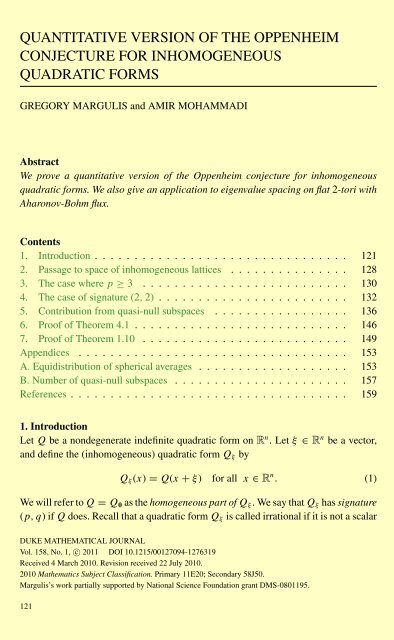NEAR OPTIMAL BOUNDS IN FREIMAN'S THEOREM
NEAR OPTIMAL BOUNDS IN FREIMAN'S THEOREM
NEAR OPTIMAL BOUNDS IN FREIMAN'S THEOREM
You also want an ePaper? Increase the reach of your titles
YUMPU automatically turns print PDFs into web optimized ePapers that Google loves.
QUANTITATIVE VERSION OF THE OPPENHEIM<br />
CONJECTURE FOR <strong>IN</strong>HOMOGENEOUS<br />
QUADRATIC FORMS<br />
GREGORY MARGULIS and AMIR MOHAMMADI<br />
Abstract<br />
We prove a quantitative version of the Oppenheim conjecture for inhomogeneous<br />
quadratic forms. We also give an application to eigenvalue spacing on flat 2-tori with<br />
Aharonov-Bohm flux.<br />
Contents<br />
1. Introduction . . . . . . . . . . . . . . . . . . . . . . . . . . . . . . . . 121<br />
2. Passage to space of inhomogeneous lattices . . . . . . . . . . . . . . . 128<br />
3. The case where p ≥ 3 . . . . . . . . . . . . . . . . . . . . . . . . . . 130<br />
4. The case of signature (2, 2) . . . . . . . . . . . . . . . . . . . . . . . . 132<br />
5. Contribution from quasi-null subspaces . . . . . . . . . . . . . . . . . 136<br />
6. Proof of Theorem 4.1 . . . . . . . . . . . . . . . . . . . . . . . . . . . 146<br />
7. Proof of Theorem 1.10 . . . . . . . . . . . . . . . . . . . . . . . . . . 149<br />
Appendices . . . . . . . . . . . . . . . . . . . . . . . . . . . . . . . . . . 153<br />
A. Equidistribution of spherical averages . . . . . . . . . . . . . . . . . . . 153<br />
B. Number of quasi-null subspaces . . . . . . . . . . . . . . . . . . . . . . 157<br />
References . . . . . . . . . . . . . . . . . . . . . . . . . . . . . . . . . . . 159<br />
1. Introduction<br />
Let Q be a nondegenerate indefinite quadratic form on R n . Let ξ ∈ R n beavector,<br />
and define the (inhomogeneous) quadratic form Qξ by<br />
Qξ(x) = Q(x + ξ) for all x ∈ R n . (1)<br />
We will refer to Q = Q0 as the homogeneous part of Qξ. We say that Qξ has signature<br />
(p, q) if Q does. Recall that a quadratic form Qξ is called irrational if it is not a scalar<br />
DUKE MATHEMATICAL JOURNAL<br />
Vol. 158, No. 1, c○ 2011 DOI 10.1215/00127094-1276319<br />
Received 4 March 2010. Revision received 22 July 2010.<br />
2010 Mathematics Subject Classification. Primary 11E20; Secondary 58J50.<br />
Margulis’s work partially supported by National Science Foundation grant DMS-0801195.<br />
121

















